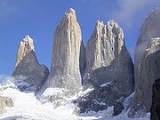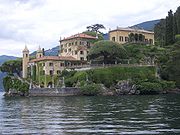
Guido Monzino
Encyclopedia


Italy
Italy , officially the Italian Republic languages]] under the European Charter for Regional or Minority Languages. In each of these, Italy's official name is as follows:;;;;;;;;), is a unitary parliamentary republic in South-Central Europe. To the north it borders France, Switzerland, Austria and...
mountain climber and explorer. In 1973 he led the first Italian expedition to climb Mount Everest
Mount Everest
Mount Everest is the world's highest mountain, with a peak at above sea level. It is located in the Mahalangur section of the Himalayas. The international boundary runs across the precise summit point...
.
Life
Monzino was born on 2 March 1928 in MilanMilan
Milan is the second-largest city in Italy and the capital city of the region of Lombardy and of the province of Milan. The city proper has a population of about 1.3 million, while its urban area, roughly coinciding with its administrative province and the bordering Province of Monza and Brianza ,...
. In his early twenties he climbed the Matterhorn
Matterhorn
The Matterhorn , Monte Cervino or Mont Cervin , is a mountain in the Pennine Alps on the border between Switzerland and Italy. Its summit is 4,478 metres high, making it one of the highest peaks in the Alps. The four steep faces, rising above the surrounding glaciers, face the four compass points...
. Subsequently he made a total of 21 expeditions to places including Patagonia
Patagonia
Patagonia is a region located in Argentina and Chile, integrating the southernmost section of the Andes mountains to the southwest towards the Pacific ocean and from the east of the cordillera to the valleys it follows south through Colorado River towards Carmen de Patagones in the Atlantic Ocean...
, Equatorial Africa
Equatorial Africa
Equatorial Africa is an ambiguous term that is sometimes used to refer to tropical Africa, or the region of Sub-Saharan Africa traversed by the equator....
, Greenland
Greenland
Greenland is an autonomous country within the Kingdom of Denmark, located between the Arctic and Atlantic Oceans, east of the Canadian Arctic Archipelago. Though physiographically a part of the continent of North America, Greenland has been politically and culturally associated with Europe for...
, the North Pole
North Pole
The North Pole, also known as the Geographic North Pole or Terrestrial North Pole, is, subject to the caveats explained below, defined as the point in the northern hemisphere where the Earth's axis of rotation meets its surface...
and the Himalaya, and sometimes following in the footsteps of the famous explorer and mountaineer Luigi Amedeo, Duke of the Abruzzi
Luigi Amedeo, Duke of the Abruzzi
Prince Luigi Amedeo Giuseppe Maria Ferdinando Francesco di Savoia-Aosta , Duke of the Abruzzi , was an Italian nobleman, mountaineer and explorer of the royal House of Savoy...
(1873–1933).
Guido Monzino died on 11 October 1988. He was interred at the Villa del Balbianello
Villa del Balbianello
The Villa del Balbianello is a villa in the comune of Lenno , Italy, overlooking Lake Como.It is located on the tip of a small wooded peninsula on the western shore of the south-west branch of Lake Como, not far from the Isola Comacina and is famous for its elaborate terraced gardens.The villa was...
on the banks of Lake Como
Lake Como
Lake Como is a lake of glacial origin in Lombardy, Italy. It has an area of 146 km², making it the third largest lake in Italy, after Lake Garda and Lake Maggiore...
, his last home. The villa today contains a museum devoted to Monzino which includes artefacts acquired on his expeditions including Inuit
Inuit
The Inuit are a group of culturally similar indigenous peoples inhabiting the Arctic regions of Canada , Denmark , Russia and the United States . Inuit means “the people” in the Inuktitut language...
sculpture, as well as memorabilia including one of the dog sled
Dog sled
A dog sled is a sled pulled by one or more sled dogs used to travel over ice and through snow. Numerous types of sleds are used, depending on their function. They can be used for dog sled racing.-History:...
s from his 1971 expedition to the North Pole, and Monzino’s extensive collections of maps and books.
Expeditions
- 1955 West AfricaWest AfricaWest Africa or Western Africa is the westernmost region of the African continent. Geopolitically, the UN definition of Western Africa includes the following 16 countries and an area of approximately 5 million square km:-Flags of West Africa:...
– SenegalSenegalSenegal , officially the Republic of Senegal , is a country in western Africa. It owes its name to the Sénégal River that borders it to the east and north...
, GuineaGuineaGuinea , officially the Republic of Guinea , is a country in West Africa. Formerly known as French Guinea , it is today sometimes called Guinea-Conakry to distinguish it from its neighbour Guinea-Bissau. Guinea is divided into eight administrative regions and subdivided into thirty-three prefectures...
and Côte d'IvoireCôte d'IvoireThe Republic of Côte d'Ivoire or Ivory Coast is a country in West Africa. It has an area of , and borders the countries Liberia, Guinea, Mali, Burkina Faso and Ghana; its southern boundary is along the Gulf of Guinea. The country's population was 15,366,672 in 1998 and was estimated to be... - 1956 Western Alps in Italy and SwitzerlandSwitzerlandSwitzerland name of one of the Swiss cantons. ; ; ; or ), in its full name the Swiss Confederation , is a federal republic consisting of 26 cantons, with Bern as the seat of the federal authorities. The country is situated in Western Europe,Or Central Europe depending on the definition....
– Grandes Murailles - 1957–1958 PatagoniaPatagoniaPatagonia is a region located in Argentina and Chile, integrating the southernmost section of the Andes mountains to the southwest towards the Pacific ocean and from the east of the cordillera to the valleys it follows south through Colorado River towards Carmen de Patagones in the Atlantic Ocean...
n AndesAndesThe Andes is the world's longest continental mountain range. It is a continual range of highlands along the western coast of South America. This range is about long, about to wide , and of an average height of about .Along its length, the Andes is split into several ranges, which are separated...
– Torres del Paine, including the first ascent of the North Tower of Paine - 1959 KarakoramKarakoramThe Karakoram, or Karakorum , is a large mountain range spanning the borders between Pakistan, India and China, located in the regions of Gilgit-Baltistan , Ladakh , and Xinjiang region,...
mountain rangeMountain rangeA mountain range is a single, large mass consisting of a succession of mountains or narrowly spaced mountain ridges, with or without peaks, closely related in position, direction, formation, and age; a component part of a mountain system or of a mountain chain...
, PakistanPakistanPakistan , officially the Islamic Republic of Pakistan is a sovereign state in South Asia. It has a coastline along the Arabian Sea and the Gulf of Oman in the south and is bordered by Afghanistan and Iran in the west, India in the east and China in the far northeast. In the north, Tajikistan...
– including the first ascent of Kanjut Sar I - 1959–1960 Equatorial AfricaEquatorial AfricaEquatorial Africa is an ambiguous term that is sometimes used to refer to tropical Africa, or the region of Sub-Saharan Africa traversed by the equator....
– Kilimanjaro - 1960 Western GreenlandGreenlandGreenland is an autonomous country within the Kingdom of Denmark, located between the Arctic and Atlantic Oceans, east of the Canadian Arctic Archipelago. Though physiographically a part of the continent of North America, Greenland has been politically and culturally associated with Europe for...
– 66th parallel north66th parallel northThe 66th parallel north is a circle of latitude that is 66 degrees north of the Earth's equatorial plane, about 61km south of the Arctic Circle. It crosses the Atlantic Ocean, Europe, Asia and North America.... - 1960–1961 Equatorial Africa – Mount KenyaMount KenyaMount Kenya is the highest mountain in Kenya and the second-highest in Africa, after Kilimanjaro. The highest peaks of the mountain are Batian , Nelion and Point Lenana . Mount Kenya is located in central Kenya, just south of the equator, around north-northeast of the capital Nairobi...
- 1961 Western Greenland – 74th parallel north74th parallel northThe 74th parallel north is a circle of latitude that is 74 degrees north of the Earth's equatorial plane, in the Arctic. It crosses the Atlantic Ocean, Europe, Asia, the Arctic Ocean and North America....
- 1961–1962 Equatorial Africa – Mountains of the MoonMountains of the MoonMountains of the Moon can refer to:* List of mountains on the Moon, mountains on Luna* Mountains of the Moon , a mountain range in Africa that is the source of the Nile River* Mountains of the Moon , a 1990 film...
and Ruwenzori - 1962 Western Greenland – 72nd parallel north72nd parallel northThe 72nd parallel north is a circle of latitude that is 72 degrees north of the Earth's equatorial plane, in the Arctic. It crosses the Atlantic Ocean, Europe, Asia, the Arctic Ocean and North America....
by sled - 1962 Western Greenland – 77th parallel north77th parallel northThe 77th parallel north is a circle of latitude that is 77 degrees north of the Earth's equatorial plane, in the Arctic. It crosses the Atlantic Ocean, Europe, Asia, the Arctic Ocean and North America....
- 1963 Eastern Greenland – Stauning Alps
- 1963–1964 Saharan Africa – Tibesti
- 1968 Western Greenland – a nautical expedition
- 1969 Western Greenland – IlulissatIlulissatIlulissat is a town in the Qaasuitsup municipality in western Greenland, located approximately north of the Arctic Circle. With the population of 4,546 as of 2010, it is the third-largest settlement in Greenland, after Nuuk and Sisimiut....
to QaanaaqQaanaaqQaanaaq is the main town in the northern part of the Qaasuitsup municipality in northwestern Greenland. It is one of the northernmost towns in the world. The inhabitants of Qaanaaq speak the West Greenlandic language and many also speak Inuktun. The town has a population of 626 as of 2010...
by sled - 1969 71st Italian expedition to the North PoleNorth PoleThe North Pole, also known as the Geographic North Pole or Terrestrial North Pole, is, subject to the caveats explained below, defined as the point in the northern hemisphere where the Earth's axis of rotation meets its surface...
- 1970 Qaanaaq to Cape ColumbiaCape ColumbiaCape Columbia is the northernmost point of land of Canada, located on Ellesmere Island in the Qikiqtaaluk Region of Nunavut. It marks the westernmost coastal point of Lincoln Sea in the Arctic Ocean...
- 1970 Western Greenland, a nautical expedition
- 1971 Cape Columbia to the North Pole by sled
- 1973 Himalaya, NepalNepalNepal , officially the Federal Democratic Republic of Nepal, is a landlocked sovereign state located in South Asia. It is located in the Himalayas and bordered to the north by the People's Republic of China, and to the south, east, and west by the Republic of India...
– leader of the first Italian expedition to ascend Everest

